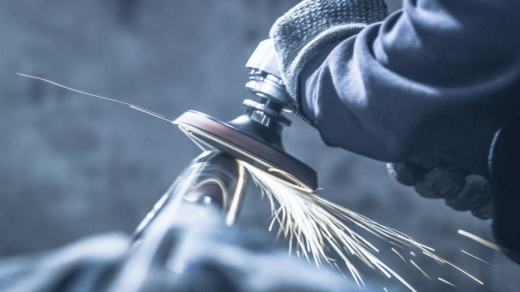When you think of polished metal, what comes to mind? Maybe it’s the gleaming chrome of a classic car, the smooth, reflective surface of a kitchen faucet, or the shining parts of machinery that hum along without a hitch. Metal polishing is the secret behind these lustrous finishes, but it’s much more than just a cosmetic procedure. It’s a process that enhances both the appearance and functionality of metal surfaces, making them more durable and less prone to damage.
In this article, we’ll explore the art and science of metal polishing, breaking down its benefits, the different methods used, and why you should consider it for your projects—whether you’re restoring a vintage item or improving the lifespan of everyday metal objects.
What Is Metal Polishing, Really?
At its core, metal polishing is a process of smoothing and shining metal surfaces to a reflective, glossy finish. It involves using abrasives, polishes, and sometimes chemical treatments to remove imperfections, scratches, or oxidation that can accumulate over time. You might think of polishing as a way to make metal look pretty, but it’s also an essential part of preserving and protecting metal from rust, corrosion, and wear.
The process itself can vary depending on the type of metal, the desired finish, and the tools at hand. But no matter the method, the goal is the same: to create a surface that’s as smooth as possible, reducing friction and enhancing durability. So, next time you admire a shiny piece of metal, remember—there’s a lot more going on than just a polished surface.
Why Should You Consider Metal Polishing?
You might be wondering, “What’s the big deal with polishing? Why not just leave the metal as it is?” Well, here’s why you should care:
- Improved Durability and Corrosion Resistance
Polished metal surfaces are less likely to oxidize or rust. By smoothing out imperfections and removing contaminants, the metal becomes more resistant to environmental damage. This makes metal polishing particularly useful for outdoor items, like garden tools, car parts, and machinery that face the elements. - Aesthetic Appeal
Let’s not beat around the bush—polished metal is beautiful. The shine, the smoothness, the way it reflects light—it all contributes to the visual appeal of a product. Whether it’s a well-maintained piece of jewelry, a sleek automobile, or shiny kitchen appliances, a polished finish takes an item from ordinary to extraordinary. - Enhanced Functionality
For machinery and moving parts, a polished surface reduces friction, which means less wear and tear. Think about it: when parts rub together without sufficient smoothness, they cause heat and wear. A well-polished surface minimizes this, ensuring the machinery runs more efficiently and lasts longer. - Increased Value
If you’ve ever tried to sell a piece of metal equipment or an antique, you know that a polished finish can increase its value. Whether it’s a collectible item, a vintage car, or a polished copper fixture, a shiny, well-maintained appearance signals quality and care. It’s a simple way to make something look more expensive, even if it’s not.
How Is Metal Polishing Done?
Metal polishing isn’t a one-size-fits-all kind of process. There are several methods to achieve that gleaming finish, depending on the metal type, the desired results, and the available tools. Let’s break it down:
1. Hand Polishing
Hand polishing is a tried-and-true method for achieving a high-quality finish, especially for smaller items like jewelry, antique pieces, or decorative metal objects. The process involves manually rubbing the metal surface with abrasive materials like sandpaper, polishing cloths, or buffing wheels. As you move through finer abrasives, the metal surface becomes smoother and shinier.
While it’s a labor-intensive approach, hand polishing gives you complete control over the finish and is ideal for intricate or delicate items. The downside? It’s time-consuming and can be physically demanding, especially for larger surfaces.
2. Machine Polishing
For larger surfaces, or when you need to polish something quickly, machine polishing is the way to go. This method involves using powered tools like rotary buffers or polishing machines. The machine uses polishing compounds to smooth out the surface and bring out the shine. Machine polishing is faster and more efficient than hand polishing, especially for larger objects, like car bodies or industrial equipment.
There are two main types of machines used for polishing:
- Rotary Buffers: These are great for a high-gloss finish and are typically used for automotive and metalworking applications.
- Dual-Action Polishing Machines: These are gentler than rotary buffers and provide a more uniform finish, making them perfect for softer metals like aluminum.
3. Electropolishing
Electropolishing is a more specialized method, typically used for stainless steel and other alloys. It involves immersing the metal in an electrolytic bath where an electric current removes the outer layer of metal. The result? A smooth, polished surface that’s resistant to corrosion and easier to clean.
This method is often used in industries like food processing, pharmaceuticals, and aerospace, where the metal needs to be smooth, clean, and resistant to corrosion. Electropolishing doesn’t just polish the metal; it also enhances its resistance to rust and corrosion, making it ideal for parts that will be exposed to harsh environments.
4. Chemical Polishing
Similar to electropolishing, chemical polishing involves using a chemical solution to smooth and polish the metal surface. Unlike electropolishing, which requires electrical current, chemical polishing relies purely on the action of chemicals to remove imperfections. This method is often used for aluminum and other lightweight metals.
Chemical polishing is typically faster than mechanical polishing and provides a uniform finish, making it ideal for high-volume applications or when you need a quick turnaround.
Tips for Getting the Best Results
Achieving a flawless polish isn’t always as simple as rubbing a cloth over the surface. Here are a few tips to help you get the best results:
- Choose the Right Polishing Compound: Different metals require different types of polishing compounds. Be sure to use the one that’s best suited to your material, whether it’s a fine abrasive for jewelry or a heavy-duty compound for industrial equipment.
- Work in Stages: Start with coarser abrasives to remove any major imperfections, then work your way through finer grits to achieve a smooth, high-gloss finish.
- Clean Between Steps: After each polishing stage, clean the surface to remove dust and debris. This prevents new scratches from forming during the next phase.
- Take Your Time: Rushing the process can lead to uneven results. Metal polishing takes patience and precision, so don’t cut corners.
- Wear Protection: Polishing machines can throw up debris, so always wear safety glasses, gloves, and a dust mask, especially when working with power tools or chemicals.
Conclusion: Why Metal Polishing Is Worth the Effort
Whether you’re polishing a classic car, restoring an antique, or simply maintaining a kitchen appliance, metal polishing is a process that yields impressive results. It’s not just about making metal shine—it’s about improving durability, reducing wear and tear, and even increasing the value of an item.
By choosing the right technique and putting in the time and care, you can transform any metal surface into something sleek, shiny, and functional. So, next time you look at that tarnished metal object, remember: with a little polishing, you can bring it back to life, making it last longer and look better than ever.

